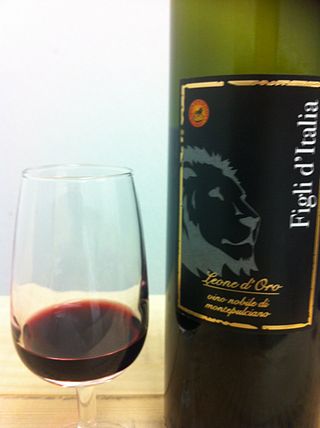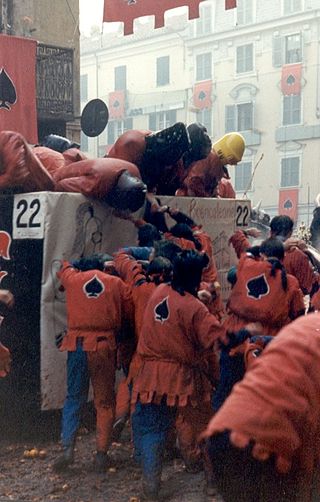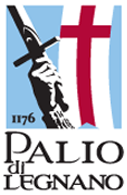
Palio is the name given in Italy to an annual athletic contest, very often of a historical character, pitting the neighbourhoods of a town or the hamlets of a comune against each other. Typically, they are fought in costume and commemorate some event or tradition of the Middle Ages and thus often involve horse racing, archery, jousting, crossbow shooting, and similar medieval sports. Once purely a matter of local rivalries, many have now become events that are staged with an eye to visitors and foreign tourists.

The Palio di Siena is a horse race held twice each year, on 2 July and 16 August, in Siena, Italy. Ten horses and riders, bareback and dressed in the appropriate colours, represent ten of the seventeen contrade, or city wards. The Palio held on 2 July is named Palio di Provenzano, in honour of the Madonna of Provenzano, a Marian devotion particular to Siena which developed around an icon from the Terzo Camollia area of the city. The Palio held on 16 August is named Palio dell'Assunta, in honour of the Assumption of Mary.

Italian wine is produced in every region of Italy. Italy is the world's largest producer of wine, with an area of 702,000 hectares under vineyard cultivation, and contributing a 2013–2017 annual average of 48.3 million hl of wine. In 2018 Italy accounted for 19 per cent of global production, ahead of France and Spain. Italian wine is both exported around the world and popular domestically among Italians, who consume an average of 42 litres per capita, ranking fifth in world wine consumption.

Montepulciano is a medieval and Renaissance hill town and comune in the Italian province of Siena in southern Tuscany. It sits high on a 605-metre (1,985 ft) limestone ridge, 13 kilometres (8 mi) east of Pienza, 70 kilometres (43 mi) southeast of Siena, 124 kilometres (77 mi) southeast of Florence, and 186 kilometres (116 mi) north of Rome by car.
A contrada is generally a district within the Italian countryside. In the city of Siena, the term indicates the 17 urban wards, whose representatives race on horseback in the Palio di Siena, run twice every year in July and August. Each sienese contrada is named after an animal or symbol, with a long history and complicated heraldic and semi-mythological associations.

Racing flags are traditionally used in auto racing and similar motorsports to indicate track conditions and to communicate important messages to drivers. Typically, the starter, sometimes the grand marshal of a race, waves the flags atop a flag stand near the start/finish line. Track marshals are also stationed at observation posts along the race track in order to communicate both local and course-wide conditions to drivers. Alternatively, some race tracks employ lights to supplement the primary flag at the start/finish line.

The Ancona is a breed of chicken which originated in the Marches, region of Italy, but which was bred to its present type mainly in the United Kingdom in the nineteenth century. It is named after the city of Ancona, capital of the Marche. It is popular in Britain and the United States, but uncommon in Italy; an initiative to re-establish it in its native area and preserve its biodiversity was launched in 2000. There are also Ancona bantams.

Vino Nobile di Montepulciano is a red wine with a denominazione di origine controllata e garantita status produced in the vineyards surrounding the town of Montepulciano, Italy. The wine is made primarily from the Sangiovese grape varietal, blended with Canaiolo Nero (10%–20%) and small amounts of other local varieties such as Mammolo. The wine is aged for 2 years ; three years if it is a riserva. The wine should not be confused with Montepulciano d'Abruzzo, a red wine made from the Montepulciano grape in the Abruzzo region of east-central Italy.

Nizza Monferrato is a comune (municipality) in the Province of Asti in the Italian region of Piedmont, located about 60 kilometres (37 mi) southeast of Turin and about 20 kilometres (12 mi) southeast of Asti.

Cavriana is a comune (municipality) in the Province of Mantua in the Italian region Lombardy, part of the municipalities of Alto Mantovano.

The Diocese of Montepulciano-Chiusi-Pienza is a Latin Church diocese of the Catholic Church in Tuscany. It has existed in the current form since 1986. In that year the diocese of Chiusi-Pienza was united into the historical Diocese of Montepulciano. The diocese is a suffragan of the Archdiocese of Siena-Colle di Val d'Elsa-Montalcino.

Uruguay requires its residents to register their motor vehicles and display vehicle registration plates.

The Carnival of Ivrea is a festival in the Northern Italian city of Ivrea, which includes a tradition of throwing of oranges between organized groups, known as the "Battle of the Oranges". It is the largest food fight in Italy and surrounding countries.

Montisi is an Italian village in the municipality of Montalcino, Province of Siena, Tuscany. It sits on a hill on the boundary between the Val d'Orcia and the Crete Senesi.

Traditions of Italy are sets of traditions, beliefs, values, and customs that belongs within the culture of Italian people. These traditions have influenced life in Italy for centuries, and are still practiced in modern times. Italian traditions are directly connected to Italy's ancestors, which says even more about Italian history.

Abruzzo is an Italian wine region located in the mountainous central Italian region of Abruzzo, along the Adriatic Sea. It is bordered by the Molise wine region to the south, Marche to the north and Lazio to the west. Abruzzo's rugged terrain, 65% of which is mountainous, help to isolate the region from the winemaking influence of the ancient Romans and Etruscans in Tuscany, but the area has had a long history of wine production.

The traditional cuisine of Abruzzo is eclectic, drawing on pastoral, mountain, and coastal cuisine. Staples of Abruzzo cuisine include bread, pasta, meat, fish, cheese, and wine. The isolation which has characterized the region for centuries has ensured the independence of its culinary tradition from those of nearby regions. Local cuisine was widely appreciated in a 2013 survey among foreign tourists.

The Palio di Legnano is a traditional event generally held on the last Sunday of May in the City of Legnano, Italy, to recall the Battle of Legnano held on 29 May 1176 by the Lombard League and the Holy Roman Empire of Frederick Barbarossa. This Palio is composed by a medieval pageant and a horse race. Until 2005 the whole event was named Sagra del Carroccio.

The contrade of Legnano are the eight historical subdivisions into which the city of Legnano, in Lombardy, in Italy, is divided. They participate annually in the Palio di Legnano.

The Contrada of the Tortoise is one of the seventeen historic subdivisions of the Tuscan city of Siena. It takes part in the Palio di Siena.



















